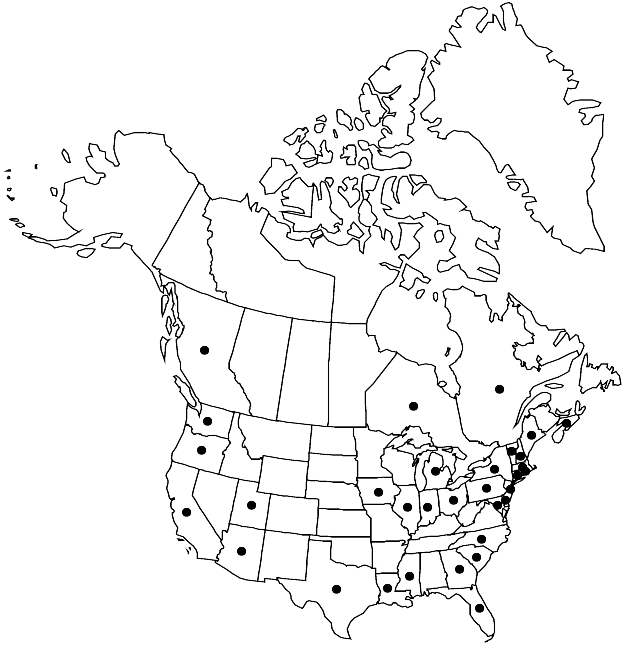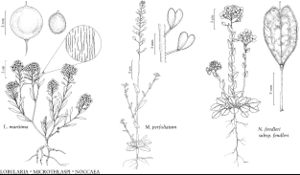Difference between revisions of "Lobularia maritima"
J. Bot. Agric. 3: 162. 1815.
FNA>Volume Importer |
imported>Volume Importer |
||
| Line 8: | Line 8: | ||
}} | }} | ||
|common_names=Sweet-alyssum | |common_names=Sweet-alyssum | ||
| + | |special_status={{Treatment/ID/Special_status | ||
| + | |code=W | ||
| + | |label=Weedy | ||
| + | }}{{Treatment/ID/Special_status | ||
| + | |code=I | ||
| + | |label=Introduced | ||
| + | }}{{Treatment/ID/Special_status | ||
| + | |code=F | ||
| + | |label=Illustrated | ||
| + | }} | ||
|basionyms={{Treatment/ID/Basionym | |basionyms={{Treatment/ID/Basionym | ||
|name=Clypeola maritima | |name=Clypeola maritima | ||
| Line 38: | Line 48: | ||
|elevation=0-800 m | |elevation=0-800 m | ||
|distribution=B.C.;N.S.;Ont.;Que.;Ariz.;Calif.;Conn.;Del.;Fla.;Ga.;Ill.;Ind.;Iowa;La.;Maine;Md.;Mass.;Mich.;Miss.;N.H.;N.J.;N.Y.;N.C.;Ohio;Oreg.;Pa.;R.I.;S.C.;Tex.;Utah;Vt.;Wash.;Europe;Asia;Africa;introduced also in Mexico;West Indies;Central America;South America;Pacific Islands;Australia. | |distribution=B.C.;N.S.;Ont.;Que.;Ariz.;Calif.;Conn.;Del.;Fla.;Ga.;Ill.;Ind.;Iowa;La.;Maine;Md.;Mass.;Mich.;Miss.;N.H.;N.J.;N.Y.;N.C.;Ohio;Oreg.;Pa.;R.I.;S.C.;Tex.;Utah;Vt.;Wash.;Europe;Asia;Africa;introduced also in Mexico;West Indies;Central America;South America;Pacific Islands;Australia. | ||
| + | |introduced=true | ||
|discussion=<p><i>Lobularia maritima</i> is widely cultivated as an ornamental; many cultivars are on the market. It was introduced to North America because of its drought tolerance and attractive, scented white flowers (R. Ornduff 1974). It has been reported as cultivated in the northern United States back to 1856 (A. Gray 1856). The cultivars naturalize very easily and have been known as locally established garden escapes in North America back to the end of the nineteenth century (N. L. Britton and A. Brown 1896–1898, vol. 2).</p> | |discussion=<p><i>Lobularia maritima</i> is widely cultivated as an ornamental; many cultivars are on the market. It was introduced to North America because of its drought tolerance and attractive, scented white flowers (R. Ornduff 1974). It has been reported as cultivated in the northern United States back to 1856 (A. Gray 1856). The cultivars naturalize very easily and have been known as locally established garden escapes in North America back to the end of the nineteenth century (N. L. Britton and A. Brown 1896–1898, vol. 2).</p> | ||
|tables= | |tables= | ||
| Line 61: | Line 72: | ||
|publication title=J. Bot. Agric. | |publication title=J. Bot. Agric. | ||
|publication year=1815 | |publication year=1815 | ||
| − | |special status= | + | |special status=Weedy;Introduced;Illustrated |
| − | |source xml=https:// | + | |source xml=https://bibilujan@bitbucket.org/aafc-mbb/fna-data-curation.git/src/bb6b7e3a7de7d3b7888a1ad48c7fd8f5c722d8d6/coarse_grained_fna_xml/V7/V7_974.xml |
|tribe=Brassicaceae tribe Malcolmieae | |tribe=Brassicaceae tribe Malcolmieae | ||
|genus=Lobularia | |genus=Lobularia | ||
Revision as of 00:03, 28 May 2020
Plants suffruticose (when subshrubs). Stems 0.5–2.5(–4) dm. Leaves: blade linear or lanceolate-oblanceolate, (1–)1.6–2.5(–4.2) cm × (1–)2–3(–7) mm, base attenuate, apex acute. Racemes elongated in fruit, (1–)4–8(–16) cm, (dense). Fruiting pedicels (3–)4.5–6(–9.5) mm. Flowers: sepals often tinged purplish, (1.4–)1.5–1.7(–2.4) mm; petals broadly obovate, (1.9–)2.3–2.8(–3.1) × (1.2–)1.6–2(–2.6) mm, abruptly contracted into claw; filaments 1.2–2 mm; anthers 0.3–0.5 mm. Fruits (1.9–)2.3–2.7(–4.2) × (1.2–)1.6–2(–2.9) mm; valve margins thin, sparsely pubescent; style 0.4–0.6 mm. Seeds light to reddish brown, not winged, (1–)1.2–1.4(–2) × (0.7–)1–1.1(–1.6) mm. 2n = 24.
Phenology: Flowering year-round (peak spring–summer).
Habitat: Roadsides, waste places, vacant lots, cultivated fields, walls, coastal fir zone, mainly along Atlantic, Gulf, and Pacific coasts, also ephemeral inland
Elevation: 0-800 m
Distribution

Introduced; B.C., N.S., Ont., Que., Ariz., Calif., Conn., Del., Fla., Ga., Ill., Ind., Iowa, La., Maine, Md., Mass., Mich., Miss., N.H., N.J., N.Y., N.C., Ohio, Oreg., Pa., R.I., S.C., Tex., Utah, Vt., Wash., Europe, Asia, Africa, introduced also in Mexico, West Indies, Central America, South America, Pacific Islands, Australia.
Discussion
Lobularia maritima is widely cultivated as an ornamental; many cultivars are on the market. It was introduced to North America because of its drought tolerance and attractive, scented white flowers (R. Ornduff 1974). It has been reported as cultivated in the northern United States back to 1856 (A. Gray 1856). The cultivars naturalize very easily and have been known as locally established garden escapes in North America back to the end of the nineteenth century (N. L. Britton and A. Brown 1896–1898, vol. 2).
Selected References
None.
